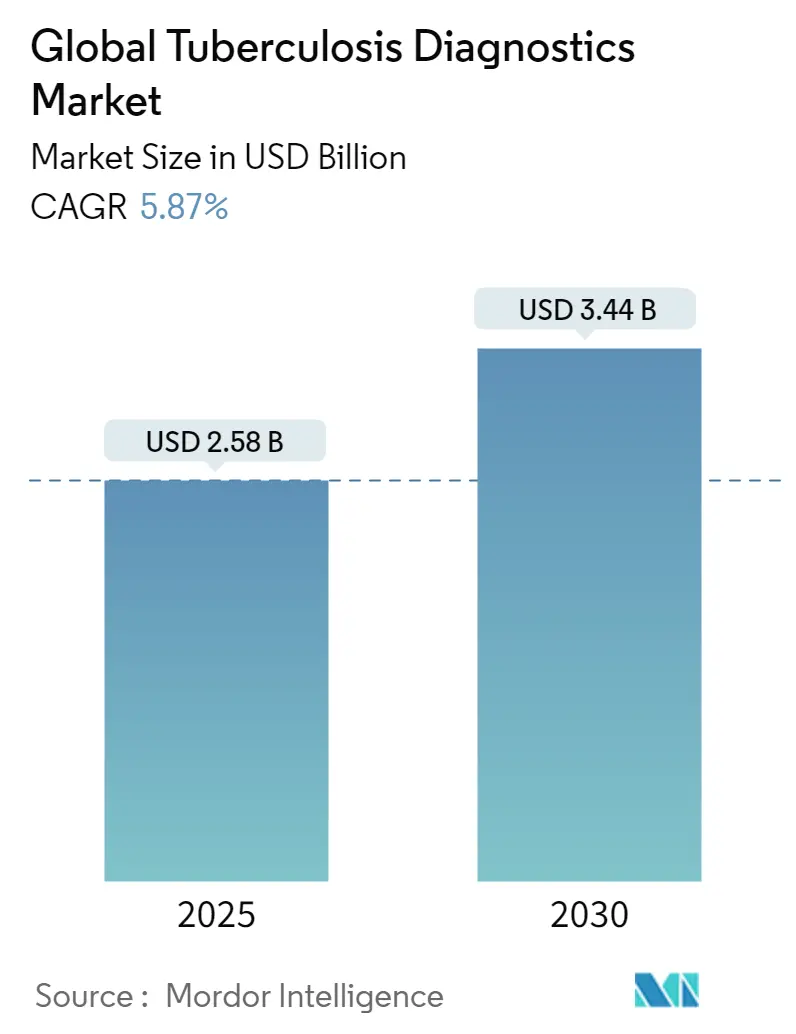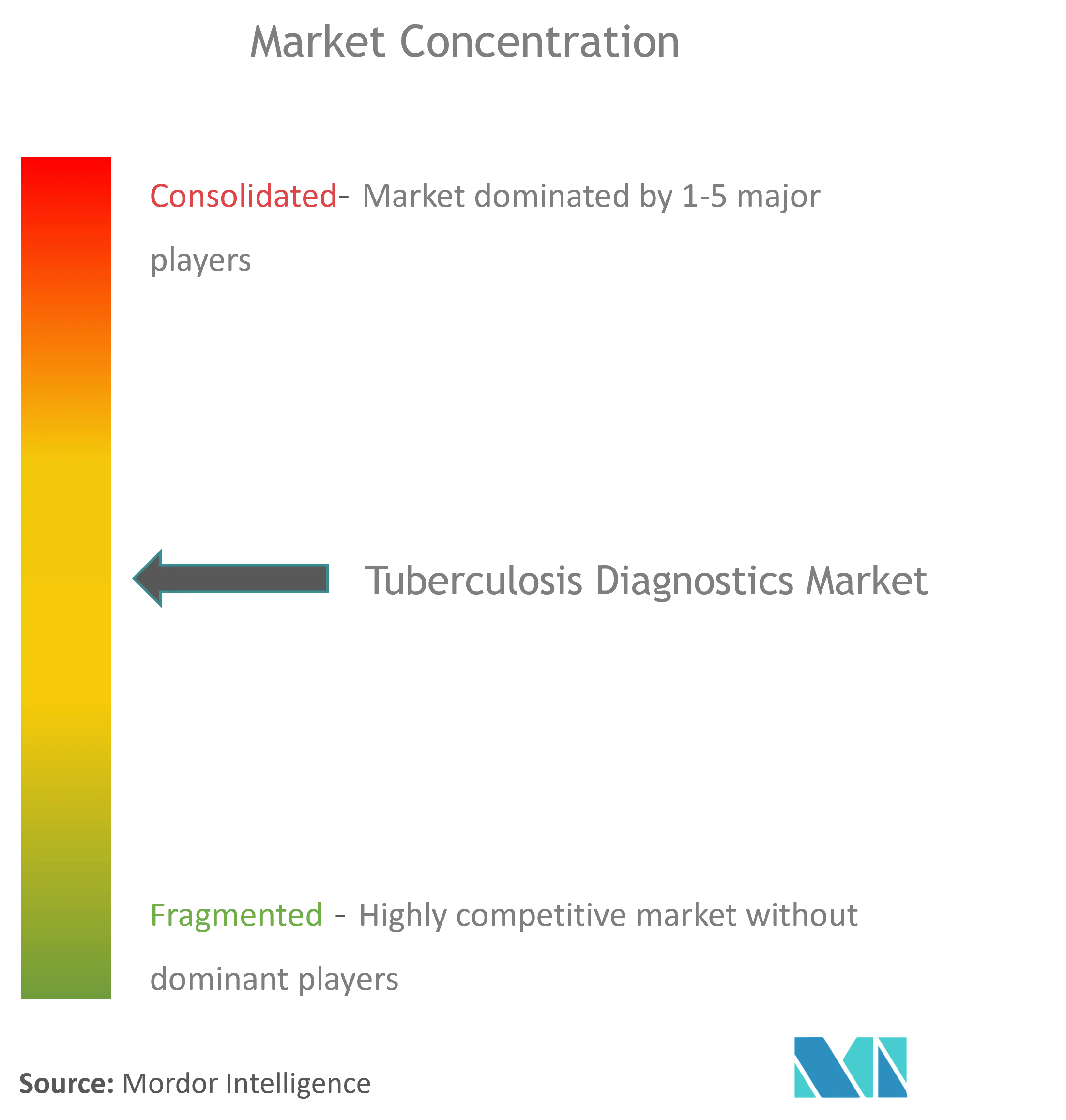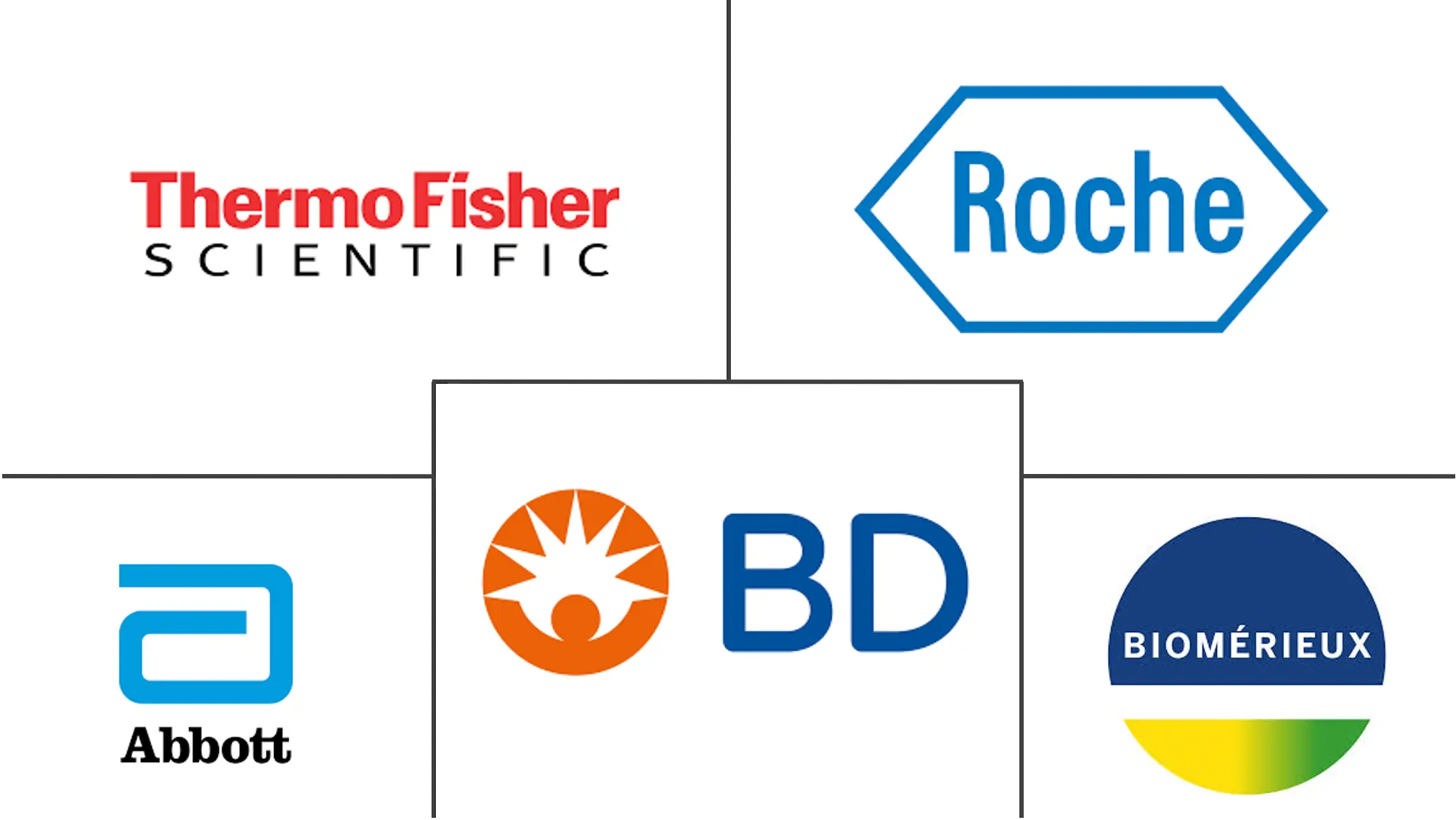Global Tuberculosis Diagnostics Market Size and Share

Global Tuberculosis Diagnostics Market Analysis by Mordor Intelligence
The tuberculosis diagnostics market stood at USD 2.58 billion in 2024 and is expected to reach USD 3.44 billion by 2030, advancing at a 5.87% CAGR. Accelerated demand stems from the roughly 4 million tuberculosis cases that go undetected every year and from the December 2024 WHO approval of Xpert MTB/RIF Ultra, a rapid molecular test that can confirm infection and drug resistance in a single visit[1]Source: World Health Organization, "WHO announces first prequalification of a tuberculosis diagnostic test," who.int . Laboratories are abandoning weeks-long culture protocols in favor of nucleic-acid amplification platforms, which have become the centerpiece of most national testing algorithms[2]Source: World Health Organization, "Consolidated guidelines on tuberculosis diagnosis," who.int . AI-guided digital microscopy and portable point-of-care assays—such as Tulane University's lab-in-tube device that returns results in under an hour at a cost below USD 3—are widening access in community clinics and mobile units. Asia-Pacific is on track for the quickest expansion as high-burden countries shift from smear microscopy to molecular testing, while North America maintains the largest revenue base thanks to entrenched laboratory infrastructure. Competitive intensity remains moderate, as Cepheid has installed more than 20,000 GeneXpert systems in high-burden nations, but cartridge supply constraints and a multibillion-dollar funding gap flagged by U.S. public-health agencies threaten to slow broader scale-up.
Key Report Takeaways
• By test type, nucleic acid amplification tests led with 36.45% of tuberculosis diagnostics market share in 2024.
• By technology, molecular diagnostics commanded 43.23% share of the tuberculosis diagnostics market size in 2024, while AI-enhanced digital microscopy is projected to expand at a 7.14% CAGR through 2030.
• By end-user, diagnostic laboratories held 48.98% revenue share in 2024; point-of-care settings are forecast to grow at a 6.67% CAGR to 2030.
• By region, North America accounted for 38.89% of the tuberculosis diagnostics market in 2024, whereas Asia-Pacific is expected to register the fastest 6.74% CAGR over the same horizon.
Global Tuberculosis Diagnostics Market Trends and Insights
Driver Impact Analysis
| Driver | (~) % Impact on CAGR Forecast | Geographic Relevance | Impact Timeline |
|---|---|---|---|
| Rising prevalence of drug-resistant TB strains | +1.2% | Global, with highest impact in post-Soviet states and Asia-Pacific | Medium term (2-4 years) |
| WHO endorsement & national roll-outs of NAAT platforms | +1.8% | Global, with accelerated adoption in LMICs | Short term (≤ 2 years) |
| Government funding & global health initiatives | +1.1% | LMIC focus, with spillover to developed markets | Long term (≥ 4 years) |
| Emergence of AI-powered microscopy & digital radiology triage | +0.9% | Global, with early gains in India, China, Nigeria | Medium term (2-4 years) |
| Decentralised near-POC molecular platforms | +0.7% | Rural and peripheral settings globally | Medium term (2-4 years) |
| Subscription-based diagnostics-as-a-service models | +0.4% | North America & EU, expanding to APAC | Long term (≥ 4 years) |
| Source: Mordor Intelligence | |||
Rising Prevalence of Drug-Resistant TB Strains
Drug-resistant cases climbed to 465,000 in 2024, yet only 43% were correctly diagnosed, intensifying the call for rapid molecular susceptibility testing. Germany’s 5.7% multidrug-resistant incidence and Côte d’Ivoire’s 22% rifampicin resistance among retreatment cases show how resistance patterns differ by geography. Xpert MTB/XDR delivers actionable drug profiles in 90 minutes, while Abbott’s RealTime MTB RIF/INH assay achieves 94.8% sensitivity for rifampicin and 88.3% for isoniazid, letting clinicians tailor therapy promptly. Nations are also piloting targeted next-generation sequencing to map resistance comprehensively, moving diagnostic workflows from culture-dependent to molecular-first approaches.
WHO Endorsement & National Roll-Outs of NAAT Platforms
WHO's March 2024 guideline update placed molecular rapid tests at the front of all diagnostic algorithms and introduced targeted sequencing guidance for drug-resistant surveillance. India's Initiative for Promoting Affordable and Quality TB Tests boosted Xpert uptake tenfold and cut prices by up to 50%, scaling from 56 to 211 labs in five years. Uganda's decentralization of NAATs to district hospitals shortened the median time to treatment initiation and increased same-day confirmations.
Government Funding & Global Health Initiatives
Despite a 16% fall in TB deaths across Global Fund–supported countries since 2002, only USD 1.2 billion flowed into TB programs in 2023 against a USD 5 billion goal. The US NIH earmarked USD 6 million for transmission studies to develop biomarker-guided interventions. Brazil’s 2023 interministerial committee coordinates nine ministries to tackle its 80,000 annual cases. Meanwhile, WHO has warned that proposed donor cutbacks could undermine crucial diagnostic services in LMICs WHO.
Emergence of AI-Powered Microscopy & Digital Radiology Triage
A study in northern India found DecXpert achieved 88% sensitivity and 85% specificity for smear-negative tuberculosis compared with GeneXpert. Siemens Healthineers teamed with the Global Fund in February 2024 to mainstream AI-read chest X-rays across Indonesia Siemens. Nigeria's Wellness on Wheels vans saw 1.75 times higher positivity where AI hotspot mapping guided deployment. Studies confirm computer-aided detection matches experienced radiologists and offers consistent performance across varied clinics, although pediatric use and non-TB anomaly triage still need refinement.
Restraint Impact Analysis
| Restraint | (~) % Impact on CAGR Forecast | Geographic Relevance | Impact Timeline |
|---|---|---|---|
| High cost of molecular tests & cartridges | -1.4% | LMICs primarily, with cost barriers in private markets | Short term (≤ 2 years) |
| Shortage of skilled laboratory infrastructure | -0.9% | Sub-Saharan Africa, rural Asia-Pacific, remote areas | Medium term (2-4 years) |
| Supply-chain fragility for single-source cartridges | -0.6% | Global, with highest impact in LMICs and remote regions | Short term (≤ 2 years) |
| Competition from emerging non-sputum biomarkers | -0.3% | Developed markets initially, expanding to LMICs | Long term (≥ 4 years) |
| Source: Mordor Intelligence | |||
High Cost of Molecular Tests & Cartridges
Traditional desktop platforms can exceed USD 19,000, while Tulane's lab-in-tube device costs under USD 800 and keeps per-test pricing below USD 3. Economic analyses in Brazil and India showed Diaskintest at USD 22.6 and USD 41.0 per correct case, while TSPOT.TB delivered greater effectiveness at incremental costs of USD 55-74. Cepheid's cost-price cartridge offer narrows the gap, yet a sustainable reimbursement model remains critical for widespread adoption.
Shortage of Skilled Laboratory Infrastructure
A proficiency survey in Ethiopia revealed only 81.92% competency in smear microscopy, with performance tied to refresher training and years of experience. Sub-Saharan facilities reported 66% Xpert coverage but only 4% Line Probe Assay uptake due to funding and workforce limitations. WHO's laboratory manual emphasizes quality-assured capacity building, and the CDC's Tuberculosis Education and Training Network and the Curry International Tuberculosis Center provide ongoing webinars and hands-on coaching. Nigeria's public-private model showed that training plus instrument redistribution produced a 28-fold jump in suspected referrals.
Segment Analysis
By Test Type: Molecular Diagnostics Lead Innovation Wave
NAATs garnered 36.45% of tuberculosis diagnostics market share in 2024, benefitting from WHO’s instruction to prioritize molecular tools over smear microscopy. Although culture methods remain essential for comprehensive drug profiling, interferon-gamma release assays (IGRAs) are the fastest climber at 6.54% CAGR through 2030 as QIAreach QuantiFERON-TB shows 99% sensitivity and 94% specificity versus prior IGRA versions. Automated smear platforms now achieve 96.7% accuracy and 91.94% sensitivity, reducing manual workload. AI-supported radiography secures AUCs of 0.951-0.975 on external datasets, raising confidence in imaging triage. Beyond sputum, sonication-based tongue-swab assays and finger-sweat drug monitoring are widening specimen options, indicative of how the tuberculosis diagnostics market continues to diversify test formats.
Emerging multiplex strategies combine modalities to hit 97.9% sensitivity, though specificity is constrained at 4.9%, exposing the need for algorithmic refinement. New biomarkers in breath and plasma are meeting WHO triage targets, signalling potential replacement tests for skin screening in high-burden settings. As novel assays mature, culture methods are likely to migrate toward centralized surveillance while rapid molecular tools dominate frontline case finding within the tuberculosis diagnostics industry.

Note: Segment shares of all individual segments available upon report purchase
By Technology: AI Enhancement Transforms Traditional Methods
Molecular diagnostics own 43.23% of the tuberculosis diagnostics market size, with Xpert MTB/RIF Ultra hitting 87.5% sensitivity and 98.7% specificity, thereby avoiding previous rifampicin false positives. AI-driven digital microscopy is rising at a 7.14% CAGR, where deep learning lifts bacilli detection to 86% sensitivity against merely 29% for manual bacteriology Diagnostics. Automated culture systems use microfluidics to reach 10 CFU/ml detection thresholds and 100% specificity for non-TB mycobacteria, slashing time-to-positivity Lab on a Chip. Immunoassays centered on lipoarabinomannan now report 55.49% sensitivity in HIV-negative pulmonary cases, offering incremental gains for immunocompromised patients. Oxford Nanopore’s resistance-profiling kit illustrates how low-depth whole-genome sequencing will soon support on-site treatment decisions. Integrating Raman spectroscopy with machine learning promises rapid phenotypic resistance predictions, while plasma proteomics yields six-protein panels that comply with WHO triage criteria.
By End-User: Point-of-Care Settings Drive Decentralization
Diagnostic laboratories still comprised 48.98% of revenues in 2024, yet POC facilities are moving fastest at 6.67% CAGR as portable NAAT devices deliver sub-60-minute answers in clinics, pharmacies, and community health posts. Hospital networks are embedding district-level GeneXpert hubs; Uganda's approach netted a 55% rise in confirmed treatments when machines were installed on-site. Academic groups pioneer novel algorithms and specimen matrices, underscoring their role in continuous test optimization. In Nigeria, mobile vans doubled daily client volumes after AI hotspot mapping optimized routes. Rural India showcases the value of cartridge-based NAAT plus mobile X-ray in bridging geography gaps, while Mozambique clinicians back stool-based qPCR for patients who cannot produce sputum BMC Infectious Diseases.

Note: Segment shares of all individual segments available upon report purchase
Geography Analysis
North America represented 38.89% of the tuberculosis diagnostics market in 2024, aided by comprehensive insurance coverage and consistent CDC laboratory upgrades CDC. Asia-Pacific is forecast to expand at 6.74% CAGR thanks to India's one-third share of global burden and policy shifts from smear microscopy to NAAT. Europe posted 38,993 cases across 29 EU/EEA nations in 2023; Ukrainian refugee screening recorded 12.8 per 100,000 incidence with 26% multidrug resistance, prompting intensified entry screening. South America benefits from national Xpert scale-up, and Brazil's roll-out increased notifications by 9.7% and catalyzed multisector coordination. The Middle East and Africa see uneven progress: while Nigeria's AI-linked vans record 1.75 times higher positivity in hotspots, only 4% of labs can run Line Probe Assays. Diaskintest is cheaper than tuberculin in Brazil and India, but TSPOT.TB delivers higher accuracy at added expense, underscoring divergent procurement choices
Competitive Landscape
The tuberculosis diagnostics market remains moderately concentrated. Cepheid sustains leadership by placing more than 20,000 GeneXpert units and selling cartridges at cost in 145 eligible nations. Roche stepped up through its 2024 acquisition of LumiraDx point-of-care technology and a Gates Foundation partnership to co-develop rapid TB tests. Siemens Healthineers is using AI to differentiate, exemplified by its Global Fund collaboration that embeds algorithmic chest X-ray triage in Indonesian clinics. Abbott competes with RealTime MTB-RIF/INH and has filed for expanded WHO endorsements.
Smaller entrants address affordability gaps: Tulane’s USD 3 assay targets rural outreach. Oxford Nanopore is field-testing a sequencing-based resistance panel designed for 30-minute readouts . Start-ups are piloting subscription bundles that wrap reagent costs into per-test fees, easing up-front capital barriers for small clinics. Public-private projects such as Nigeria’s 28-fold referral surge illustrate how distribution partnerships and training packages can shift market access quickly . Yet regulatory complexity and stringent clinical evidence expectations still favor large incumbents with global QA systems.
Global Tuberculosis Diagnostics Industry Leaders
-
Abbott Laboratories
-
Becton, Dickinson and Company
-
BioMérieux SA
-
F. Hoffmann-La Roche AG
-
Thermo Fisher Scientific Inc.
- *Disclaimer: Major Players sorted in no particular order

Recent Industry Developments
- April 2025: Tulane University unveiled a portable lab-in-tube assay that returns results within one hour at sub-USD 3 per test
- December 2024: WHO awarded first prequalification to Xpert MTB/RIF Ultra, setting a new quality bar for rapid TB testing.
- July 2024: Roche closed the LumiraDx POC acquisition and launched a Gates Foundation collaboration on affordable TB NAATs.
Research Methodology Framework and Report Scope
Market Definitions and Key Coverage
Mordor Intelligence defines the tuberculosis diagnostics market as all in-vitro procedures, culture based, smear microscopy, nucleic-acid amplification, interferon-gamma release, radiographic and emerging AI-enhanced image readers used to detect latent or active human Mycobacterium tuberculosis infection across laboratory and point-of-care settings worldwide. The valuation reflects test consumables and instrument revenues booked at manufacturer level before channel mark-ups.
Scope exclusion: veterinary (bovine) tuberculosis tests and anti-TB therapeutics are outside this study.
Segmentation Overview
- By Test Type (Value)
- Culture-based Tests
- Smear Microscopy
- Nucleic Acid Amplification Tests (NAAT)/PCR
- Interferon-Gamma Release Assays (IGRA)
- Tuberculin Skin Test (Mantoux)
- Radiographic & Imaging Tests
- Other Tests
- By Technology (Value)
- Culture-based
- Molecular Diagnostics (PCR/NAAT)
- Immunoassays (IGRA/LAM)
- Radiology/X-ray
- AI-enhanced Digital Microscopy
- Others
- By End-User (Value)
- Hospitals & Clinics
- Diagnostic Laboratories
- Academic & Research Institutes
- Others
- By Geography (Value)
- North America
- United States
- Canada
- Mexico
- Europe
- Germany
- United Kingdom
- France
- Italy
- Spain
- Rest of Europe
- Asia-Pacific
- China
- India
- Japan
- South Korea
- Australia
- Rest of Asia-Pacific
- South America
- Brazil
- Argentina
- Rest of South America
- Middle East and Africa
- GCC
- South Africa
- Rest of Middle East and Africa
- North America
Detailed Research Methodology and Data Validation
Primary Research
We interviewed hospital microbiologists, national program managers, procurement officers and diagnostics distributors across Africa, South-East Asia, North America and Europe. Conversations and structured surveys confirmed lab capacity utilization, IGRA reimbursement shifts, GeneXpert installed base growth and median test pricing, enabling us to verify desk-based assumptions and surface regional nuance before final triangulation.
Desk Research
Our analysts first assembled a fact base from open, high-credibility sources such as the WHO Global TB Report, the CDC's TB surveillance tables, the Global Health Observatory, World Bank health-expenditure series and regional bodies like the ECDC. Trade data from UN Comtrade and Volza helped validate reagent shipment trends, while Questel patent analytics and D&B Hoovers company filings clarified pipeline intensity and pricing windows. Press releases, peer-reviewed journals and investor presentations filled technology and cost benchmarks.
These materials created historical volume, price and incidence series against which later primary insights were cross-checked. The list above is illustrative; many additional public and subscription assets were tapped to complete the desk review.
Market-Sizing & Forecasting
A top-down construct starts with notified TB incidence, under-diagnosis factors and screening coverage to derive total tests performed, which are then multiplied by blended average selling prices. Parallel bottom-up cross-checks, selected supplier roll-ups and sample ASP × volume audits helped align totals. Key model variables include annual TB incidence, multidrug-resistant share, IGRA penetration, NAAT instrument fleet, public health screening budgets and currency movements. Five-year projections were generated through a multivariate regression that relates test adoption to incidence, laboratory expansion and funding outlook, with scenario spreads vetted by interviewed experts. Data gaps, such as private-clinic test leakage, were bridged through ratio estimates sourced from urban pilot surveys.
Data Validation & Update Cycle
Outputs pass variance checks against independent incidence curves and reagent import trends, followed by multi-analyst peer review. Models refresh every twelve months, with interim revisions triggered by guideline changes, major funding shifts or significant product approvals. A final sanity pass is completed just before report release.
Why Mordor's Tuberculosis Diagnostics Baseline Is Trusted
Published estimates vary because firms choose unlike test menus, incidence multipliers and refresh cadences. Understanding these levers helps users judge which number best fits a decision need.
Key gap drivers include divergent inclusion of smear microscopy, differing stances on latent screening volumes, alternative ASP escalation paths and the frequency with which models are rebuilt when WHO or CDC data are revised.
Benchmark comparison
| Market Size | Anonymized source | Primary gap driver |
|---|---|---|
| USD 2.58 B (2024) | Mordor Intelligence | - |
| USD 2.28 B (2024) | Global Consultancy A | Limited test menu, excludes smear microscopy volumes |
| USD 2.28 B (2024) | Regional Consultancy B | Combines human and veterinary revenues, inflating base |
| USD 2.61 B (2024) | Industry Journal C | Omits informal private-lab testing, biennial refresh |
The comparison shows that when scope, variables and yearly update discipline are harmonized, Mordor's figure sits mid-range yet is fully traceable, offering decision-makers a balanced, dependable baseline.
Key Questions Answered in the Report
Why is the tuberculosis diagnostics market shifting from culture to molecular tests?
Rapid NAATs such as Xpert MTB/RIF Ultra deliver results in under 2 hours with 87.5% sensitivity and 98.7% specificity, whereas cultures may take weeks, aligning with WHO’s December 2024 endorsement of molecular methods
What is the current Global Tuberculosis Diagnostics Market size?
Digital microscopy supported by deep learning reached 88% sensitivity and 85% specificity in an Indian field study, outperforming conventional smear reads and ensuring consistent performance across different technicians .
What keeps molecular diagnostics costly in low-income settings?
Platform prices can exceed USD 19,000 and cartridge costs add recurring expenses; Tulane’s under-USD 800 device and sub-USD 3 tests show that price-innovations are possible but still rare
How does point-of-care testing help rural regions?
Deploying portable NAATs and mobile X-ray vans eliminates referral delays; Nigeria’s AI-guided vans doubled daily client screening volumes, while Uganda’s district labs started same-day treatment for most patients.
What role do public-private partnerships play?
Programs like India’s price-negotiating IPQNT initiative and Nigeria’s GeneXpert redistribution have lowered costs and multiplied referrals, demonstrating that shared risk and training support can accelerate uptake
Page last updated on:



